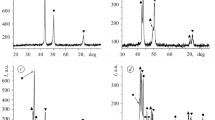Abstract
The Cr—Ni—C phase diagram at the melting point was plotted by a combination of procedures (metallography, x-ray, microprobe, differential thermal analysis, Pirani—Alterthum method, etc.). A general feature of this system is the existence of equilibria between the nickel-based phase and all the other phases. The temperature of the quasibinary (Ni)+(Cr7C3) eutectic was determined to be 1324±6°C. Based on both the phase diagram of the Cr—Ni—C system and the bending strength and Rockwell hardness of the alloys, the optimal composition of the initial carbide ingredient for production of hard alloys based on Cr3C2 with nickel—phosphorus binder was estimated as 13.0–13.3 at.%, substoichiometric with respect to Cr3C2.
Similar content being viewed by others
References
M. Pirani and H. Alterthum, “A method for melting point determination in high-melting metals”, Z. Elektrochem.,29, No. 1/2, 5–8 (1923).
T. Murakami, S. Takeda, K. Mutsuzaki, and T. Murase, “The equilibrium diagram of the Ni−Cr−C system”, Nippon Kinzoku Gakkaishi (J. Japan Inst. of Metals)4, No. 7, 189–12518 (1940); cited in [95Ter].
J. B. Hess, “A modification of the Cohen procedure for computing precision lattice constants from powder data”, Acta Cryst.,4, No. 3, 209–215 (1951).
W. Köster and S. Kabermann, “The ternary nickel—chromium—carbon system”, Arch. Eisenhüt.,26, No. 10, 627–630 (1955).
V. V. Grigor’eva and V. M. Klimenko, Alloys Based on Chromium Carbide [in Ukrainian], Vid-vo AN URSR, Kiev (1961).
V. E. Listovnichii, “Calculation of the emissivity of cylindrical cavities”, Inzh.-Fiz. Zh.,7, No. 11, 32–35 (1964).
E. Rudy, Ternary Phase Equilibria in Transition Metal—Boron—Carbon—Silicon Systems. Part V. Compendium of Phase Diagram Data: Tech. Rep. AFML-TR-65-2, U.S. Air Force Materials Laboratory (1969).
Yu. A. Kcherzhinskii, E. A. Shishkin, and V. I. Vasilenko, “DTA apparatus with thermocouple sensor up to 2200°”, in: Phase Diagrams of Metallic Systems [in Russian], Nauka, Moscow (1971), pp. 245–249.
V. S. Telegus and Yu. B. Kuz’ma, Visn. L’viv. Univ. Ser. Khim,12, 28–33 (1971).
K. Löbl, H. Tüma, and M. Ciznerova, “Activity of carbon in the Ni−Cr−C system in the carbon solubility zone”, Mémoires Scientif. Rev. Métalurg.,71, No. 5, 271–279 (1974).
H. Tüma and M. Ciznerova, “Activity of carbon in the Ni−Cr−C system in the region of chromium carbide Cr7C3 precipitation. Kovové Materialy,13, No. 6, 779–782 (1975).
J. J. Poubeau, “Solubility of carbon in chromium and precipitation of carbides in the metal”, Doctoral Thesis in Engineering, Univ. Press, Paris (1977).
V. N. Klimenko and V. A. Maslyuk, “Chromium carbide—nickel—phosphorus alloys, their properties and application”, Poroshk. Met., No. 1-2, 70–79 (1977).
V. N. Klimenko, V. A. Maslyuk, and I. D. Radomysel’skii, “Activation of sintering for chromium carbide-nickel alloys” Poroshk. Met., No. 10, 41–44 (1978).
V. I. Alekseev, I. V. Degtyarev, and G. A. Levshin, “Phase diagrams of metallic systems”, in: Thermodynamic Calculations and Experimental Methods [in Russian], Nauka, Moscow (1981), pp. 91–98 (1981).
H. Tüma and M. Ciznerova, “Thermodynamic investigations and the equilibrium diagram of the Ni−Cr−C system in the nickel-enriched region at a temperature of 1000–1200°C,”: in Kovové Materialy,20, No. 4, 426–443 (1982); H. Tüma and M. Ciznerova, “Thermodynamic investigations and the equilibrium diagram of the Ni−Cr−C system in the nickel-rich corner at 1000–1200°C,” Metal. Materials,20, No. 4, 450–467 (1982).
V. A. Maslyuk, “Structure and properties of KKhNF15 alloys made from chromium carbide powders from different production runs”, Porosh. Met. No. 12, 38–40 (1984).
J. J. Poubeau and J. Bigot, “Determination of the solubility of carbon in chromium by measuring the electrical resistivity at low temperature”, Acta Metall.,33, No. 6, 1137–1141 (1985).
P. Nash, “The Cr−Ni (chromium-nickel) system”, Bull. Alloy Phase Diagrams,7, No. 5, 466–476; 507–508 (1986).
V. N. Eremenko, T. Ya. Velikanova, and A. A. Bondar, “Phase diagram of the Cr−Mo−C system. I. Phase equilibria in the region of crystallization of alloys of the partial Mo−Mo2C−Cr7C3−Cr system”, Poroshk. Met., No. 5, 70–76 (1987).
M. F. Singleton and P. Nash, “The C−Ni (carbon-Nickel) system”, Bull. Alloy Phase Diagrams,10, No. 2, 121–126 (1989).
M. Venkatraman and J. P. Neumann, “The C−Cr (carbon-chromium) system”. Bull. Alloy Phase Diagrams,11, No. 2, 152–159 (1990).
T. B. Massalski, P. R. Subramanian, H. Okamoto, and L. Kasprzak, eds., Binary Alloy Phase Diagrams, 2nd edition, ASM International, Materials Park, Ohio (1990); 3 volumes.
P. Nash, Phase Diagrams of Binary Nickel Alloys, ASM International, Materials Park, Ohio (1991).
A. A. Bondar, V. A. Maslyuk, and A. V. Grytsiv, “Effect of the composition of the original chromium carbide on the structure and properties of chromium carbide-nickel (KKhN) alloys”, in: Phase Equilibria, Stability of Phases, and Metastable States in Metallic Systems [in Russian], Inst. Probl. Materialovedeniya im. I. N. Frantsevicha, NAN Ukrainy, Kiev (1993), pp. 148–153.
P. Villars, A. Prince, and H. Okamoto, eds., Handbook of Ternary Alloy Phase Diagrams, ASM International: The Materials Information Society, New York (1995); 10 volumes.
Additional information
Institute of Problems in Materials Science, National Academy of Sciences of Ukraine, Kiev. Translated from Poroshkovaya Metallurgiya. No. 5/6(395), pp. 13–24, May–June, 1997.
Rights and permissions
About this article
Cite this article
Bondar, A.A., Maslyuk, V.A., Velikanova, T.Y. et al. Phase equilibria in the Cr-Ni-C system and their use for developing physicochemical principles for design of hard alloys based on chromium carbide. Powder Metall Met Ceram 36, 242–252 (1997). https://doi.org/10.1007/BF02676213
Issue Date:
DOI: https://doi.org/10.1007/BF02676213




